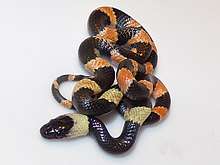Oxyrhopus petolarius
| Oxyrhopus petolarius | |
|---|---|
 | |
| Dapa, Colombia | |
| Scientific classification | |
| Kingdom: | Animalia |
| Phylum: | Chordata |
| Class: | Reptilia |
| Order: | Squamata |
| Suborder: | Serpentes |
| Family: | Colubridae |
| Genus: | Oxyrhopus |
| Species: | O. petolarius |
| Binomial name | |
| Oxyrhopus petolarius | |
| Synonyms | |
Oxyrhopus petola, commonly known as the false coral or calico snake, is a species of colubrid snake endemic to South America.[5] According to Savage (2011) the correct scientific name should be Oxyrhopus petolarius.[4]
Common names
Other common names for O. petolarius include calico snake[1] and forest flame snake.[3]
Geographic range
O. petolarius is found in central and northern South America, including Trinidad and Tobago.[5]
Description
Adults of O. petolarius may attain a total length of 91 cm (36 in), which includes a tail 22 cm (8.7 in) long.[2]
Coloration is variable. It usually consists of some combination of red and black rings or crossbands. In some individuals the light-colored crossbands are white instead of red on the anterior part of the body.[2]
The dorsal scales are smooth, with apical pits, and are arranged in 19 rows at midbody.[2]
Venom
O. petolarius is rear-fanged, and its venom is extremely toxic to anole lizards.[5]
Diet
O. petolarius feeds on lizards, frogs, small rodents, birds, and probably other snakes.[5]
Subspecies
Some authorities recognize three subspecies of O. petolarius, including the nominotypical subspecies.
- Oxyrhopus petolarius digitalis (Reuss, 1834)
- Oxyrhopus petolarius petola (Linnaeus, 1758)
- Oxyrhopus petolarius sebae A.M.C. Duméril, Bibron & A.H.A. Duméril, 1854[6]
Nota bene: A trinomial authority in parentheses indicates that the subspecies was originally described in a genus other than Oxyrhopus.
Etymology
The subspecific name, sebae, is in honor of Dutch naturalist Albertus Seba.[7]
References
- 1 2 "Oxyrhopus petola ". ITIS (Integrated Taxonomic Information System). https://www.itis.gov.
- 1 2 3 4 Boulenger GA (1896). Catalogue of the Snakes in the British Museum (Natural History). Volume III., Containing the Colubridæ (Opisthoglyphæ and Proteroglyphæ),... London: Trustees of the British Museum (Natural History). (Taylor and Francis, Printers.) xiv + 727 pp. + Plates I-XXV. (Oxyrhopus petolarius, pp. 101-103).
- 1 2 "Oxyrhopus petolarius ". The Reptile Database. http://www.reptile-database.org.
- 1 2 Savage JM (2011). "The correct species-group name for an Oxyrhopus (Squamata: Dipsadidae) variously called Coluber petalarius, C. pethola, C. petola, or C. petolarius by early authors". Proceedings of the Biological Society of Washington. 124 (3): 223–225. doi:10.2988/11-06.1.
- 1 2 3 4 Boos, Hans E.A. (2001). The Snakes of Trinidad and Tobago. College Station, Texas: Texas A&M University Press. xvi + 328 pp. ISBN 1-58544-116-3.
- ↑ Freiberg M (1982). Snakes of South America. Hong Kong: T.F.H. Publications. 189 pp. ISBN 0-87666-912-7. (Oxyrhopus petola, p. 105).
- ↑ Beolens, Bo; Watkins, Michael; Grayson, Michael (2011). The Eponym Dictionary of Reptiles. Baltimore: Johns Hopkins University Press. xiii + 296 pp. ISBN 978-1-4214-0135-5. (Oxyrhopus petola sebae, p. 240).
Further reading
- Duméril A-M-C, Bibron G, Duméril A[-H-A] (1854). Erpétologie générale ou histoire naturelle complète des reptiles. Tome septième. Deuxième partie. Comprenant l'histoire des serpents venimeux [= General Herpetology or Complete Natural History of the Reptiles. Volume 7. Part 2. Containing the Natural Histories of the Venomous Snakes]. Paris: Roret. xii + pp. 781–1536. (Oxyrhopus petolarius, pp. 1033–1036). (in French).
- Linnaeus C (1758). Systema naturæ per regna tria naturæ, secundum classes, ordines, genera, species, cum characteribus, diferentiis, synonymis, locis. Tomus I. Editio Decima, Reformata. Stockholm: L. Salvius. 824 pp. (Coluber petola, new species, p. 225). (in Latin).
- Reuss A (1834). "Zoologische Miscellen. Reptilien, Ophidier ". Mus. Senckenbergiana, Frankfurt 1: 129-162. (Coluber digitalis, new species, p. 148 + Plate IX, figure 1). (in German).
- MacCulloch RD, Lathrop A, Kok PJR, Ernst R, Kalamandeen M (2009). "The genus Oxyrhopus (Serpentes: Dipsadidae: Xenodontinae) in Guyana: morphology, distributions and comments on taxonomy". Papéis Avulsos de Zoologia 49 (36): 487–495.
External links